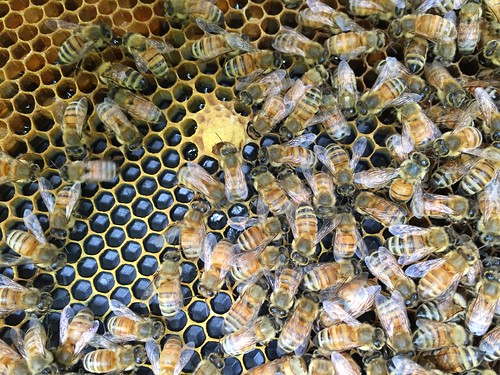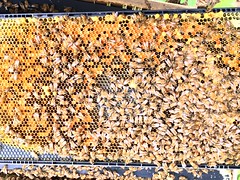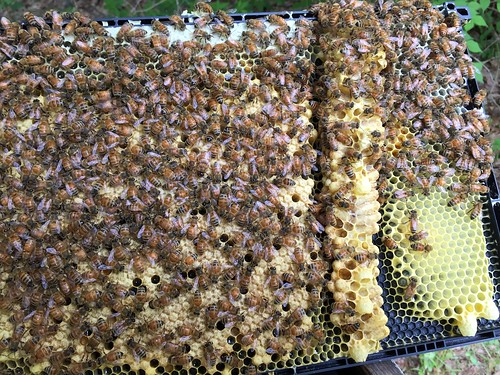The other hive - well, not so good. The top box looked nice: I saw the queen and lots of eggs and larvae she had laid. Lots of stored food. But the bottom box was different. Pulling and checking frames from right to left I came across a single dark queen succession cell. A wax igloo in the middle of the frame. This frame and the next 3 or 4, were surprisingly inactive. These are built out frames that had been used for brood, but now no eggs, larvae, or nectar. Maybe a bit of yellow-brown stuff (pollen?) at the bottom? (I'll go back and photograph this today as I am wondering now if its foul brood or some other disease.)



But that single queen succession cell seemed to make sense. Maybe my original queen can't keep up laying eggs in all the cells. BUT then, on the next frame, about 20 light colored queen swarm cells hanging down the center sideways and off the edges! So are they are planning to swarm! And succeed? Both?

What I think I'll do next (tomorrow) is (1) photograph those funny yellow-brown cells closer and see if a problem. Maybe I need to take them out. (2) Try to create more space in case they are is considering swarming due to crowding. I will move unused outer frames inward and adding a honey super. I am deciding whether to remove the queen swarm cells. A friend said she can lend me equipment if I do need to catch a swarm. But it may make sense to remove whatever swarm cells I can, leaving the succession cells.
We'll see. I'd love advice.
7 comments:
My dad is a bee farmer. Take care they almost killed him.
Sorry about being late to the party, but that strip you see are drone cells.
Queen cells are always in the vertical direction and are larger (like a peanut) Your hive just wants to have drones but your frames are all worker sized, so they build their own. Also you have queen cups, but from what I can see they aren't drawn out, they are just the small cup (if you could take a 3D image I might be able to tell if it is drawn out at all).
Are you using mediums/westerns or deeps? Depending on the opening I usually find that (unless you have a slatted rack box on the bottom) that they stay near the top of the hive and leave 3-6 inches from the bottom completely clear or maybe filled with a bit of pollen and nectar.
You'd know if it is foul brood because you would smell it. It is a very foul smell (thus the name).
Her laying pattern looks alright (you only have a single picture) so I don't think they'll supercedure her and since this is a first year queen she won't swarm.
Thank you David! I've been talking with bee keepers friends and realizing my hives are very healthy. They are storing lots of nectar and pollen in the bottom box which surprised me. And yes, seems to me the queen igloos are all empty.
I an concerned now that I have too many bees in my boxes. They are pretty much full. I added honey supers on both a couplecdays ago. Hopefully this gives them absence of more space. Wondering if I should add a third short box to each hive. I'm so excited to have supers on!!!
Ideally, you want them to have space to fill, and work to do. If every frame is chock-full, you should give them new frames to work on by adding a box. If they need the space, they will use it, if not, then they won't. You may want to consider checkerboarding the brood frames to keep the swarming impulse down.
Those little vertically oriented cells are called "queen cups," all hives make those to have on hand. A quick peek will tell you if there's any larva or royal jelly in there. If you remove queen CELLS (peanut-shell looking cells on the frames) doing so will NOT stop a swarm and you should NEVER remove queen cells unless you understand why and what the implications are.
I noticed the plastic frames are spotty in regard to drawn comb. When adding plastic foundation, you may want to add more beeswax to the foundation. Purchase a stick of beeswax from a trusted source, heat the end of it via a heat gun or some such heat source and rubbing the melted end on the frame. This allows more even drawing of the comb.
Good luck,
Anna
That's great work your are doing Kathy. Keep up.
A bee friendly reminder: never use herbicides. These toxins are part of the reason why honey bees and native pollinators are struggling for survival. Either let them grow wild and free or pay that neighborhood kid a buck to weed them for you.
A bee friendly reminder: never use herbicides. These toxins are part of the reason why honey bees and native pollinators are struggling for survival. Either let them grow wild and free or pay that neighborhood kid a buck to weed them for you.
Post a Comment